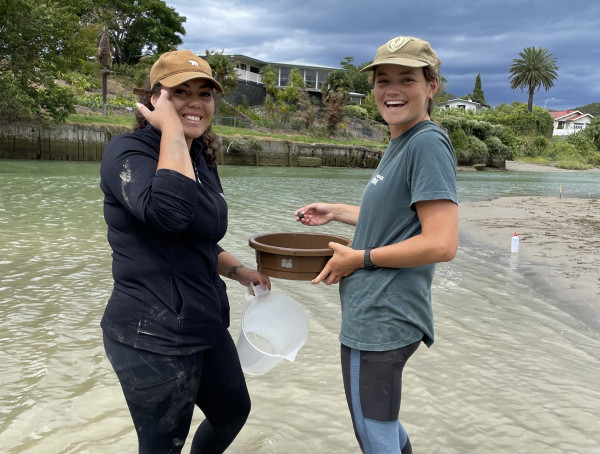Monitoring of Tῡranganui Estuary
Monitoring protocol for Tῡranganui Estuary
In 2023, Gisborne District Council (GDC) commissioned Cawthron Institute (Cawthron) to help design a long-term estuary monitoring programme[1] across Tairāwhiti /Gisborne District in conjunction with mana whenua.
Isabella Clere, Marine and Coastal Scientist from GDC says that the programme was developed with expertise from Cawthron while also collaborating with local community, iwi and hapū. She also emphasised that it was important that the monitoring programme and protocols that were developed aligned with Aotearoa New Zealand’s National Estuary Monitoring Programme (NEMP; Robertson et al. 2002)[2]. The NEMP is used by many Regional Councils as a standardised approach for monitoring the ecological condition of estuaries. Isabella says approaching the work this way has led to a robust set of monitoring protocols which incorporate a range of values and will provide information to assist in future estuary and land management.
This initial work was not funded by Envirolink however GDC began implementation of the monitoring programme in February 2024. An Envirolink Advice Grant (2339) was used to commission Cawthron to test the protocol they had developed with the local community, iwi and hapū. This work also aims to assist Council’s management and understanding of algal blooms in the Tῡranganui Estuary.
Isabella explains that the Tῡranganui Estuary is a riverine estuary and has a wide range of values, being culturally and recreationally significant, for the people of Tairāwhiti/Gisborne. The monitoring protocol focuses on assessing the sites physical, chemical and biological characteristics, which provides important information on the health of the estuary. The region’s estuaries are at risk from sediment, forestry, and land-use change so monitoring them is essential to allow for early detection of environmental changes.

Shellfish monitoring in Tῡranganui Estuary (GDC)
The work completed by Cawthron provides an assessment of the current environmental conditions and ecological health of the Tῡranganui Estuary. Parameters measured included detailed analysis of two sites for epibiota, infaunal macroinvertebrates, sediment quality, shellfish abundance and woody debris. Additional data (water quality, birds, woody debris, and marine mammals) from other monitoring has also been included.
Isabella commented that the work has provided an important information baseline which GDC can continue to build on to inform the management of the Tῡranganui Estuary. She says “We hope to do ongoing monitoring to identify environmental trends in the estuary over time and incorporate any further techniques to ensure we are collecting the best information to inform decision making”.
[1] Clark D, Berthelsen A, Ho M, Alder A, Luke A, Clere I, Hewitt J. 2024. Monitoring protocol for Tūranganui Estuary. Nelson: Cawthron Institute. Cawthron Report 4013. Prepared for Gisborne District Council.
[2] https://environment.govt.nz/publications/national-estuary-monitoring-protocol/
Last modified: